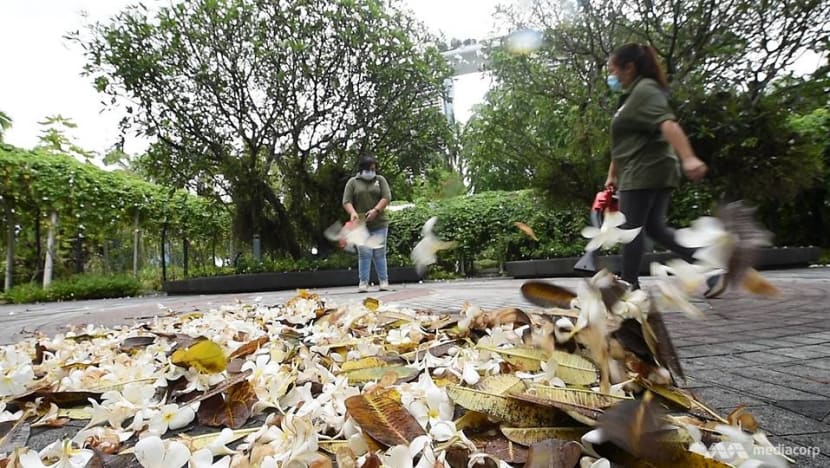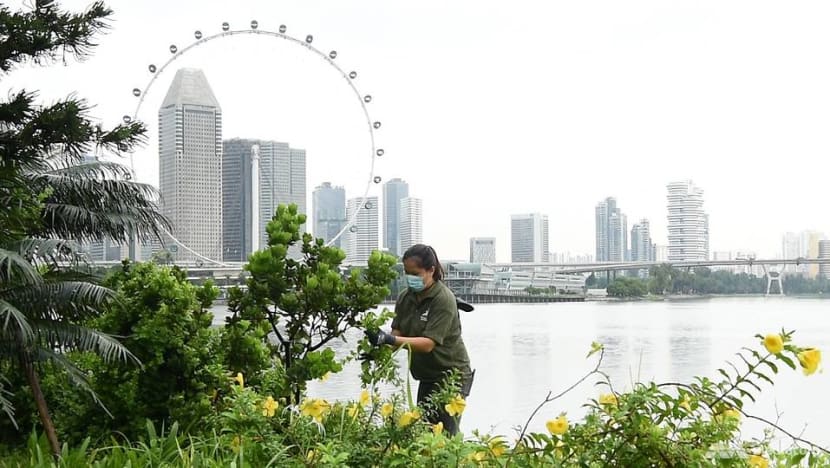Going the extra mile to keep Gardens by the Bay neat and tidy during the COVID-19 circuit breaker

Irene and Grace pruning against a backdrop of the Marina Bay Sands. (Photo: Jeremy Long)
SINGAPORE: Gardens by the Bay horticulturist Irene Chong, 32, crouched as she snipped off stalk after stalk of cat's whiskers plant. Then she stood to throw the stalks into a big white bag beside. Then she crouched again.
With the sun blazing overhead and sweat trickling down her forehead, Irene, a gardens operations manager, might as well have been doing burpees.
Irene wasn't exercising but pruning a patch of plants adorning the giant floral clock in the gardens. The key is to keep the plants to a short and uniform height, so they look easy on the eye and don't block what's behind.
To achieve this, workers first go in with a large pair of shears to level off tall stalks. Then they step back to check the height, before going in again for further trimming.
After that's done, they use smaller cutters to snip off stalks just above the leaf nodes, which is where the leaves grow out. This is the proper way to prune plants and encourage new growth.
Earlier this month, CNA got the opportunity to work alongside staff who maintain Gardens by the Bay to see what goes into keeping such popular attractions in prime condition despite the drop in visitor numbers during the "circuit breaker".
This involved clearing fallen leaves, shearing overgrown shrubs and pruning plants.
The latter task is mundane, repetitive and done in sweltering heat, but Irene didn't seem to mind. "It can be quite therapeutic," she told me.
Barely 10 minutes into the pruning, I threw my tools aside after what I thought was a job well done. I had amassed a fistful of pentas plant stalks, and so I patted myself on my wet back.
The truth is I was thirsty and exhausted, and the blue surgical mask I had on didn't help. On a normal day, Irene said this regular-sized patch would have taken two workers about two hours to finish.
But these are not normal days at the gardens.
In Singapore, the COVID-19 pandemic has forced most people to work from home. At the park, which is not possible to maintain from home, authorities have capped the number of workers on the ground each day.
Gardens operations senior director Andy Kwek said this means his 39-strong team, half made up of foreign workers, has been reduced to about 11 people.
“It is not something that we can avoid,” the 49-year-old said. “Given that all of them have passion for the plants, they’re very willing to step up and do some of the more laborious things that they don’t typically do as horticulturists.”
Andy said maintenance has to continue even with fewer daily visitors – 2,000 down from 14,000 before the circuit breaker – to "keep things in order" and uphold the park's image.
So staff like Irene, whose primary roles include deciding how to landscape the gardens and checking that flowers and trees are neat and healthy, are themselves getting down and dirty.
"I think we enjoy it," she said, when I asked about the additional work. "We work as a team, you see. We also learn to know each other better.
"We didn't work together like this; we have individual areas to take care of. So in a way, you have to find fun in what you're doing. Definitely, it's very exhausting."
Andy, towel draped around his neck, teased her and drew laughter. "Wow, can sign extra," he said, referring to punishing someone with extra duties.
CLEARING LEAVES
The boss sat in the shade after a particularly taxing shift clearing leaves from a main visitor walkway, one of the "high-touch points" in the park. This involves using a blower to first gather leaves in a long pile, then a motorised cart to pick them up.
He showed me how to start the blower up: Flick a switch and tug at a string three times. The 6kg handheld device sputtered and groaned into life. It was probably the closest I would get to operating a chainsaw.

The blower was light enough to be carried with one hand, but heavy enough to be tricky to manoeuvre. I wandered among the Supertrees with this bad boy in hand, searching for some leaves to shove around.
The thing is, the blower ejects a faint gust even while idle, so you could inadvertently blow leaves away while walking, making things messier. The correct method is to walk with the nozzle pointed upwards. Therein lies the difficulty.
The satisfaction of pushing the trigger, hearing the loud roar and seeing the leaves scurry was not enough to soothe my aching biceps. The sun wasn't getting cooler either. I used both hands to swing the blower, as the leaves went places I did not want them to.

Thankfully it was soon time to pick them up using the motorised cart. It is essentially a single-seat buggy fitted with a huge vacuum, not unlike the mechanical sweepers you see on the roads.
Inside there are buttons to control the nozzle elevation and suction strength. Andy advised me to always go full power, with the nozzle just high enough to suck up the leaves.
While the cart was easy to drive, the picking up was less than straightforward. I drove over the long lines of leaves expecting to leave a clean trail, but what I saw in the rear view mirror were haphazard leftovers on either side.

Andy assured me that I didn't mess up. But the wise thing to do, he said, is to mentally divide the piles in half and go over each section. If you drive through the middle from the start, the engine exhaust could scatter the leaves.
I made a U-turn to try his strategy and got better results, but the cart still didn't pick everything up. The suction just didn't seem strong enough. Andy said workers usually use a rake to sweep up what's left. It's faster that way.
DEALING WITH PUBLIC FEEDBACK
Regardless of speed, plant pruning and leaf clearing are daily tasks. Some spots see more shedding, and thus require clearing twice a day. With plants growing at different rates in different nooks of the 0.54-sq km park, there is no fixed timetable.
Andy said his colleagues would walk in their designated areas each morning to see what needs trimming and attending to. They would also work on feedback from visitors.
"Sometimes they will say the plants are overgrown and are covering some of the nice scenery," Irene said. Added Andy: "During two weeks of hot weather, some complained about the pond being dry."

While the staff admitted this scrutiny is one of the challenges of the job, they don't shy away from putting in effort to ensure the park lives up to expectations.
"We also want to be prepared for after the circuit breaker, we want to have the gardens ready," said fellow horticulturist and gardens operations assistant manager Grace Yang, 30. "I don't know when, but eventually visitors will come back."
GAINING AN APPRECIATION
This drive was something I was interested to find out more about. How does someone fall in love with gardening?
Both Irene and Grace have diplomas in horticulture. They studied plant structures, how plants grow and even their scientific names. For Irene, the hobby runs deeper.
"It's in the family," she said, adding that her father loves gardening and being in nature. In his free time, he would go out to the Sungei Buloh wetland reserve. Now that he's semi-retired, he grows orchids at home.
"He's actually very good at it," she added with a laugh. "Out of his three children, only I inherited his interest."

Indeed, it takes a certain level of interest and skill to do their jobs.
Landscaping, for instance, is not just about deciding what plants and flowers complement the park's aesthetics. It's also about knowing whether the plant thrives in heat, how quickly it grows and the type of soil and fertiliser it needs.
I left Gardens by the Bay with a new appreciation for the hard work that goes in to keep it nice and tidy. It's one of those things where you really only notice the end product.
What delights staff the most is seeing the fruits – or flowers – of their labour, often in vibrant hues of pink and white.
"If the landscaping turns out to be nice, and people actually enjoy it and take photos, then you also feel very satisfied," Irene said.
Added Grace: "The trees we have in the gardens are a bit special, they are not your typical roadside trees. So when they bloom or fruit in surprise, we are very happy."















